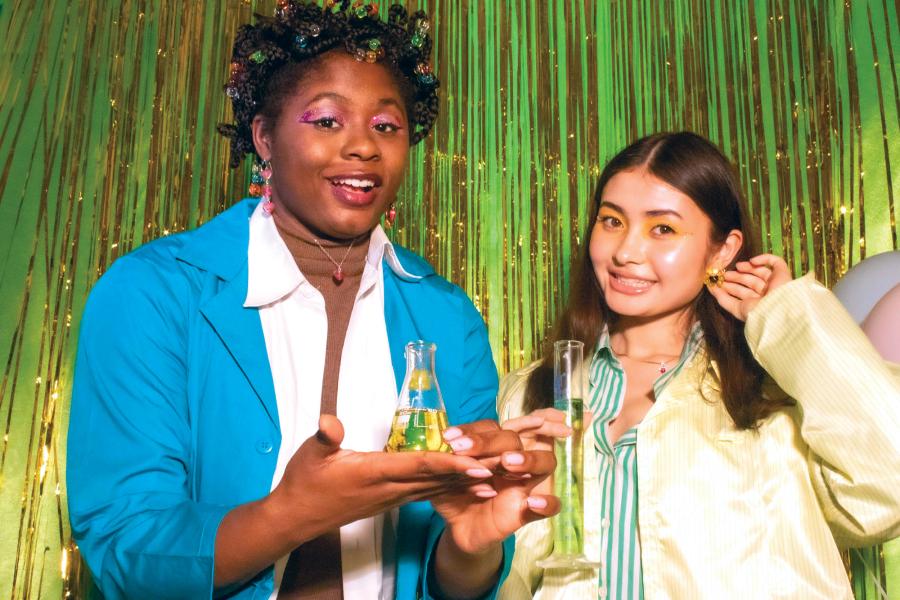During the early days of the pandemic, Mecca McDonald, A&S '21, discovered that resin jewelry was having a moment on TikTok. The longtime sustainability enthusiast wanted an earth-friendly alternative but couldn't find one. She reached out to Mia Dunn, Engr '21— a stylish chemical and biomolecular engineer she knew through a mutual friend—asking if Dunn wanted to work together on creating bioplastic jewelry from scratch.
For the next few months amid remote classes, the pair met at each other's houses, embarking on a trial-and-error process to develop a biodegradable plastic that would have the same properties as resin. Some bioplastics are protein-based, but they ultimately landed on a starch-based recipe for their first prototype: an earring. Once they arrived at a semi-transparent plastic that evoked gelatinous candy, Mo.Na. Gems was born.
During spring semester of their senior year, they created a working prototype and were accepted into FastForward U, Johns Hopkins' accelerator program for student-led startups. "If we didn't join FFU, we probably would not have started selling when we did," McDonald says, because they had previously been focused on perfecting their product. "And we got a great initial response."
Part of that response came from TikTok, where the brand has gone viral a few times, amassing 3 million or 4 million views on short video clips. Today, their TikTok account boasts 140,000 followers, a clear sign of demand for their product—and their philosophy.
"We've been conditioned to view plastic as the norm. People don't realize that we can live in a plastic-free world," McDonald says.
Here, the Mo.Na. Gems founders share what they've learned in their first two years of business.
Can you talk me through the process of making one of these pieces?
MD: I do the manufacturing. It involves making the formula, which is liquid, and then to get the shape, we use silicon molds. We can get the molds custom designed or buy them on Amazon. A lot of resin artists use these molds for their pieces, too. We get a mold and then after we pour the liquid into the mold, it cures, and then after it dries, it probably takes 24 hours to fully harden. After that we hook them and use sterling silver hardware and also gold-plated sterling-silver hardware.
MM: We only started selling our pilot product because those were the molds we had. The later designs came from more thoughtfulness and things we enjoy.
How does TikTok play into the business and your marketing?
MD: Because the resin trend was popular on TikTok, we got some attention when people saw us being like, "No, not the resin trend, look at this bioplastic jewelry!" Our following grew very quickly. One summer, we tried posting TikToks three times a day to see what would happen, and in a month, we gained 15,000 followers and it kept on going. But a lot of people find us through Instagram now.
What do you think about the miscon¬ception that choosing a STEM field means sacrificing artistic creativity?
MM: I firmly believe that art and science go together. They're just different forms of creativity. It's the way science has been branded as this thing that's clinical, sterile, straight and narrow, but the essence of science is curiosity and discovery, which is also the essence of creating art. They're the same thing, just in different forms. If Mia and I weren't both artists outside of Mo.Na. Gems [Mia is a freelance artist, and Mecca has a photography business], I don't know how long we would have kept doing it. As an artist, you're always like, "I'm going to try something new!" and sometimes it looks ugly. But you don't take it personally.
MD: Being in school makes you scared to fail, it makes you scared to try new things. People should be encouraged to try new things and accept the fact that it's OK to fail. Failure is not something to be scared of.
While launching Mo.Na. Gems, were there any mistakes that you learned from?
MD: Accelerator programs always emphasize the importance of doing customer discovery research and figuring out your target audience. We didn't do much market research before we went in. Instead, we assumed that we knew who our target audience was, which took us to a certain point. But now, we're backtracking and doing research on the specifics. Who is someone who shops at Mo.Na.? I kind of wish we had done more in the beginning. But it wasn't a "make or break" mistake. I think there's always more to learn when you're on a journey like this.
Posted in Alumni
Tagged entrepreneurship








